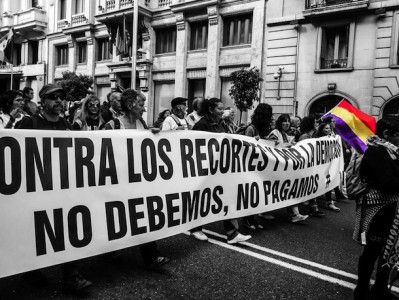MADRID, SPAIN. Saturday the 22nd of March saw Madrid turn into a confluence of slogans, banners, and chants as people from all regions of Spain got together in a multitudinous protest known as the Marches of Dignity. These “Marchas de la Dignidad” were organized by the Sindicato Andaluz de Trabajadores, Frente Cívico, the Dignity Camps from Extremadura and many other organizations. However, it is undoubtable Spanish citizens took part in the demonstrations for a wide array of different reasons.
According to Luna Falquina, a young Spanish student who participated in Saturday’s protest, the people taking part in the demonstration were protesting for many diverse issues, ranging from dissatisfaction with the cuts, the new abortion law, and an overall alienation with the current government. Falquina and her friends had already left the site when several violent encounters took place between the police and a group of extremist protesters later that night. These confrontations have left 23 detainees, 67 wounded policemen, 34 wounded citizens and a deeply divided account of the protest, courtesy of the Spanish media.
During the past week, coverage of the violent clashes has surpassed coverage of the reasons of the Spanish people taking to the streets in most of the Spanish newspapers. Right wing papers such as ABC and La Razon have emphasized the violence of the protest by publishing front cover images of demonstrators attacking the police. Meanwhile, accounts of police falsified evidence criminalizing the detainees have been rife in left wing newspapers such as publico.es. These acutely divided reports of the protest are also widespread in social media. During the past week a persistent rumour about a possible infiltration by members of the police forces posing as protesters has been popular in many social media sites. In the meantime, groups supporting the police actions and demonizing the protest as a whole have emerged on Facebook and Twitter.
Ramón Marcos Allo, a Member of Parliament for the political party Union, Progreso y Democracia (UPyD), stated in a ROOSTERGNN interview that a clear distinction needs to be made between those extreme sections using violence as a political tool and the great majority of people who demonstrated in a peaceful manner last Saturday. “There are some major issues which the Spanish people are entitled to protest about” he declared. “I mainly went because I wanted to protest about the new abortion law” said Falquina when asked about her reasons for taking part in the demonstration. “We have a voice, and we need to use it to defend our rights” she concluded.
Unfortunately, the Spanish media’s polarizing coverage of the protest’s violence has largely buried the reasons why people like Luna Falquina and the rest of the protesters participated in the Marches of Dignity last Saturday. In a country where disappointment and exasperation with the government is pervasive among large sections of our society, the Spanish media should focus less on the violence perpetrated by small extremist groups and more on the reasons behind so many people taking to the streets. A front page cover of a violent clash between police and demonstrators will certainly sell newspapers and attract readership, but as long as the issues that drive the protests are ignored, a great deal of the Spanish populace’s discontent will remain forgotten.
— Julia Tena de la Nuez

